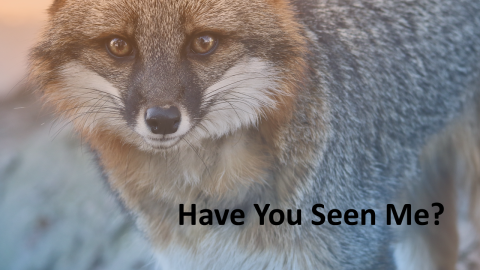Gray foxes are disappearing across the Midwest and scientists aren't sure why. The Ohio Coyote Research Team is working with the Ohio Division of Wildlife to investigate this elusive little cousin to the coyote.
About the Project
The gray fox is unique from other North American canids, with its striking coloration, highly omnivorous diet, and distinctive ability to climb trees. Despite its wide range across the most of the US, its elusive behavior and preference for dense forest habitats have hindered attempts to learn more about them. Recent reports across the Midwest suggest that gray fox numbers have been declining for the past few decades, causing concern among naturalists, wildlife managers, and fur trappers alike. The state of Ohio even listed the gray fox as a Species of Concern in 2017, prompting action to look closer at how the population is doing and what might be causing the decline.
Our team is working with a larger research effort to shed light on gray fox population trends, sources of mortality, and movement behaviors.
Where did the foxes go?
We know very little about gray fox habits. This small canid weighs about 10lbs and is about the size of a house cat. Adding this to their preference for brushy habitat, they can be difficult to find and track down. Ohio's fur trappers started noticing fewer foxes turning up starting around the 1980s, with many now saying they haven't seen one in years. So where did all the gray foxes go? Researchers are investigating several possible explanations, including competition or aggression from coyotes, rising levels of diseases such as canine distemper, and habitat conversion.
Coyotes became common across the state of Ohio around the 1980s, which is the same time that gray fox numbers seemed to nosedive. This isn't quite a smoking gun, however, because research has shown very mixed results about how coyotes and gray foxes interact. Some studies have shown that gray foxes don't seem to avoid areas used by coyotes, while other studies show a clear relationship where more coyotes coincides with fewer gray foxes. Coyotes are known to attack gray foxes when they can, and the fact that both canids eat similar foods means that coyotes might be out-competing the smaller foxes even if they occur in the same habitat. Our research on Ohio's coyote population gives us the opportunity to examine some of these relationships.
Let's find out!
Our team is analyzing coyote diet, habitat selection, and movement behavior across the state of Ohio. We are now working to collect similar data from gray foxes. To date, we have GPS-collared over 20 gray foxes, which will allow us to assess fine-scale habitat use and movement behavior. We have also been collecting whisker samples for diet analysis, like we did with the coyotes, to better understand what they are eating and what differences in diet might occur in the population. Combining these analyses will help us answer several questions:
- Do coyotes and gray foxes use the same types of habitat?
- Do coyotes and gray foxes rely on the same food sources?
- Are gray foxes active at the same times as coyotes, or do they avoid active coyote times?
- Do gray foxes have higher survival rates in areas that coyotes don't use as much, or in areas where coyotes are hunted more frequently?
- What are the common causes of gray fox mortality - and are coyotes a top contender?
Some potential impacts of coyotes on gray foxes aren't as obvious. For example, even if gray foxes might have preferred a certain habitat in the past, they might now avoid that habitat if there are coyotes there. This isn't the same as two species happily dividing resources; it could be that the foxes are being forced into a habitat that is not providing sufficient resources for them, causing lower reproductive rates, lower survival, and/or poor body condition. For this reason, we are assessing these important aspects of the gray fox population and trying to tease out the drivers.
Specifically, there is suspicion that human-modified habitats (agricultural areas, urban areas, etc) might be contributing to gray fox decline. Ohio's urban areas are expanding, and agriculture is a major feature of the Ohio landscape. As an animal that prefers dense forests, these human-modified habitats may be limiting their ability to thrive. But, the opposite could be true as well! Some studies have shown that gray foxes do well in suburban/urban areas. These foxes might benefit from the "human shield effect," where humans discourage larger carnivores from residing nearby, allowing foxes to enjoy relative safety. More research is needed to untangle the relationship between coyotes, foxes, and modified habitats.
Team effort
Clearly, this is a complex problem and there are many possible factors involving the decline of gray foxes in the Midwest. We are working with two other labs at The Ohio State University to come at the problem very several angles.
The Peterman lab is looking at the fox population's genetic diversity across the state. This will show us if there are particular barriers that are keeping foxes from dispersing. Barriers can contribute to poor genetic diversity and put a population higher risk of health problems, like lower fertility or impaired immunity, and make it harder for a population to adapt to changes in the environment. The Peterman lab is also building on our team's habitat selection analysis, but at a state-wide scale. They’re building maps that highlight which areas across the state provide the right conditions for gray foxes to live and do well.
We are also working with folks from the Pesapane lab, where they are screening foxes from around Ohio for exposure to toxic rodenticides, parasites, and diseases like canine distemper and rabies. Foxes are known to be particularly sensitive to canine distemper, which is easily transmitted by raccoons, coyotes, and skunks, but is fatal for foxes.

